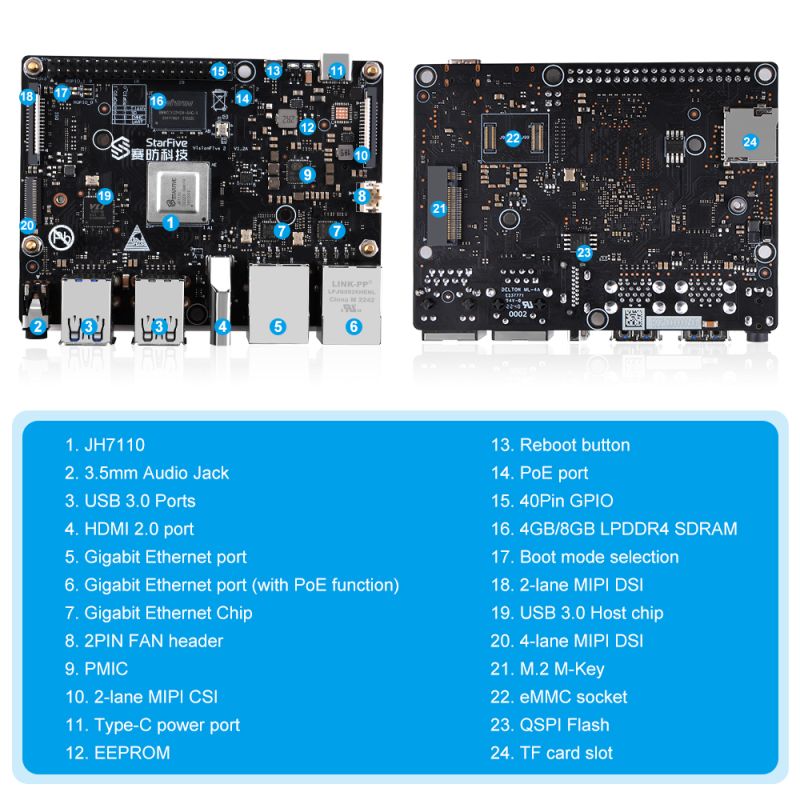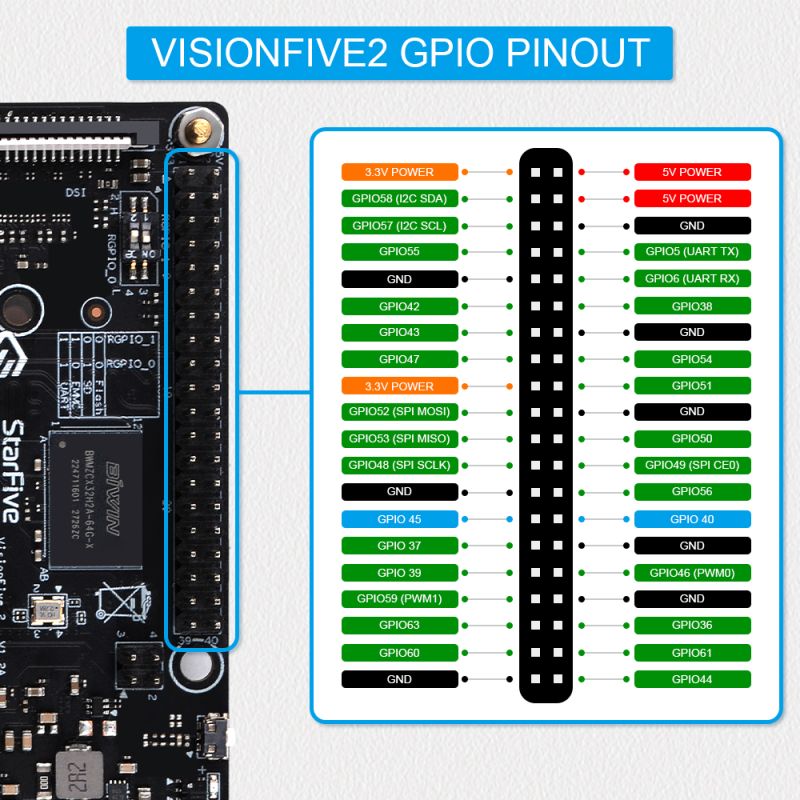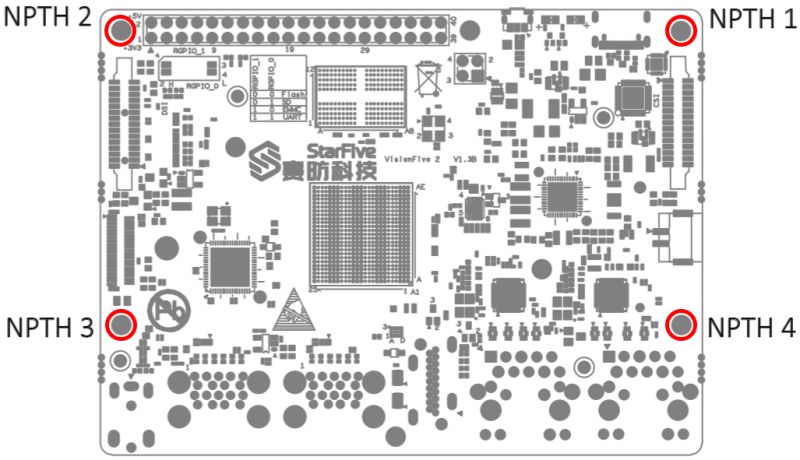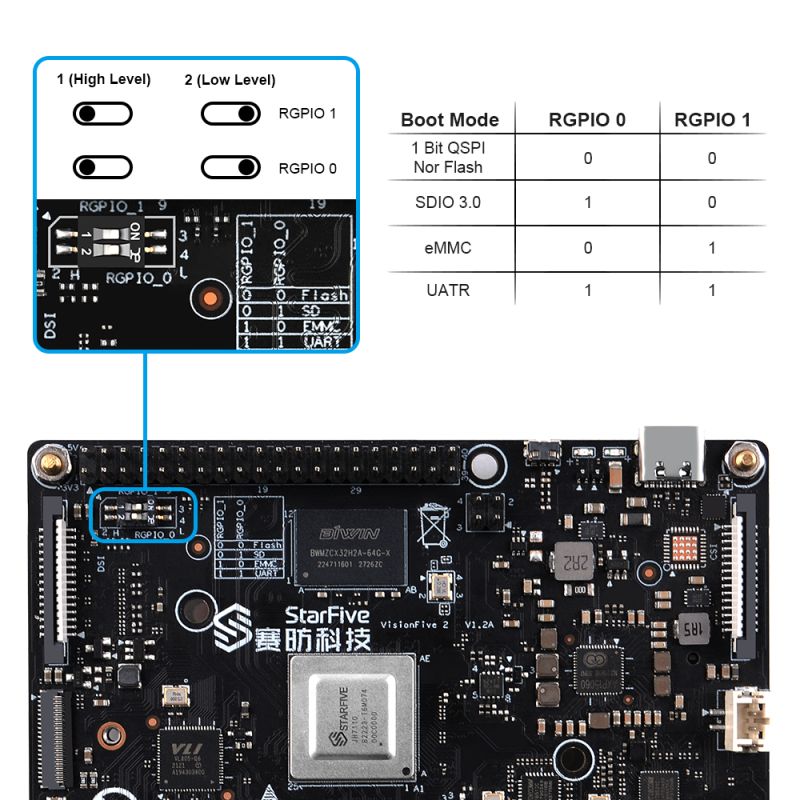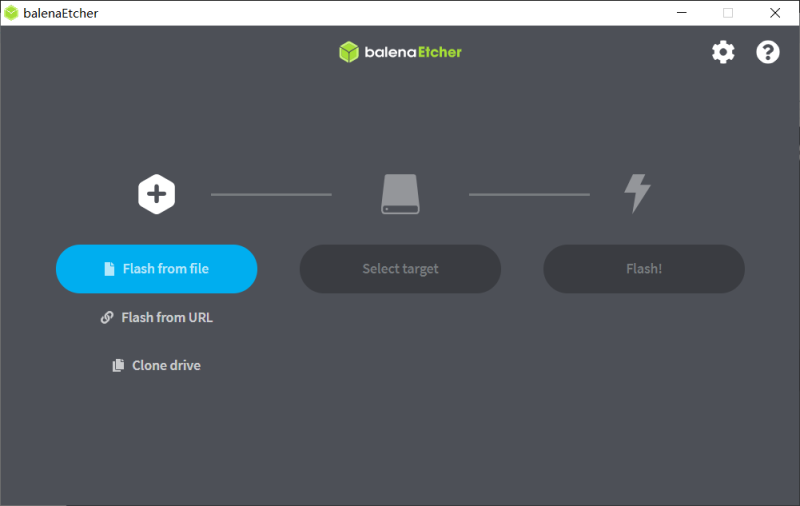ER-0043
VisionFive 2
Descriptions
VisionFive 2 is the world’s first high-performance RISC-V single board computer (SBC) with an integrated GPU. Compared with its last generation, VisionFive 2 has been fully upgraded with significant improvements in the processor work frequency, multimedia processing capabilities, scalability, etc. Its superior performance and reasonable price make VisionFive 2 the best affordable RISC-V development board ever.
VisionFive2 RISC-V Single Board Computer, StarFive JH7110 Processor With Integrated 3D GPU, Base On Linux
Hardware
Processor
- StarFive JH7110 with RISC-V quad-core CPU with 2 MB L2 cache and a monitor core, supporting RV64GC ISA, working up to 1.5 GHz
- IMG BXE-4-32 MC1 with work frequency up to 600 MHz
Memory
- VisionFive 2 provides the system memory of 2 GB, 4 GB, or 8 GB LPDDR4 SDRAM up to 2,800 Mbps.
Storage
- Onboard TF card slot: The VisionFive 2 can boot from the TF card.
- Flash: The firmware to store U-Boot and bootloader.
Video Processing
The video processing of VisionFive 2 has the following features.
- Video decoder support up to 4K@60fps and multi-stream for H264/H265
- Video encoder support up to 1080p@30fps and multi-stream for H265
- JPEG encoder/decoder
Interface
- 1 x 2-lane MIPI DSI
- 1 x 4-lane MIPI DSI
- 1 x 2-lane MIPI CSI
- 1 x 3.5 mm Audio Jack
- 1 x USB-C port for charging
- 1 x USB device port (by reusing the USB-C port)
- 4 x USB 3.0 ports (multiplexed with a PCIe 2.0 1x lane)
- 1 x HDMI 2.0
- 2 x RJ45 Ethernet ports
- 1 x 4-pin PoE header
- 1 x 2-pin fan header
- 1 x Reset button
- 1 x 40-pin GPIO header, supporting various interface options:
- 3.3 V (on 2 pins)
- 5 V (on 2 pins)
- Ground (on 8 pins)
- GPIO
- CAN bus
- DMIC
- I2C
- I2S
- PWM
- SPI
- UART
Software
Operating System VisionFive 2 supports Debian operating system. For more software resources, please follow the StarFive GitHub repository. [ https://github.com/starfive-tech ]
Specifications
| Type | Item | Description |
|---|---|---|
| Processor: | StarFive JH7110 | StarFive JH7110 with RISC-V quad-core CPU with 2 MB L2 cache and a monitor core, supporting RV64GC ISA, working up to 1.5 GHz |
| Imagination GPU | IMG BXE-4-32 MC1 with work frequency up to 600 MHz | |
| Memory: | 2 GB/4 GB/8 GB | LPDDR4 SDRAM, up to 2,800 Mbps |
| Storage: | Onboard TF card slot | The VisionFive 2 can boot from a TF card. |
| Flash | The firmware to store U-Boot and bootloader. | |
| Multimedia: | Video Output |
Note: Only one MIPI DSI port can be used for display at a time. |
| Camera | 1 × 2-lane MIPI CSI camera port, supporting up to 1080p@30fps | |
| Encoder/Decoder |
| |
| Audio | 4-pole stereo audio jack | |
| Connectivity: | Ethernet | 2 × RJ45 Gigabit Ethernet ports |
| USB Host | 4 × USB 3.0 ports (multiplexed with a PCIe 2.0 1x lane). | |
| USB Device | 1 × USB device port (by reusing the USB-C port) | |
| M.2 Connector | M.2 M-Key | |
| eMMC Socket | For eMMC modules as OS and data storage | |
| 2-Pin Fan Header | - | |
| Power: | USB-C port | 5 V DC via USB-C with PD, up to 30 W (minimum 3 A) |
| GPIO Power In | 5V DC via GPIO header (minimum 3 A) | |
| PoE (Power over Ethernet) | PoE function is enabled and requires separate PoE HAT | |
| GPIO: | 40-Pin GPIO Header | 1 × 40-pin GPIO header, supporting various interface options:
|
| Boot Mode: | Boot mode setting pins | You can choose one of the following boot modes:
|
| Button: | Reset button | To reset VisionFive 2, press and hold the Reset button for more than 3 seconds to ensure the reset is successful. |
| Dimensions: | 100 × 74 mm | - |
| Compliance: | RoHS, FCC, CE | - |
| Environment: | Recommended operating temperature | 0-50 ℃ |
| Other: | Debug function | UART TX and UART RX are available through the 40-pin GPIO header. |
| SSD mounting screw type | M2 x 3mm | Head Diameter:5.0 mm |
Board Appearance
- Parts definitions
CAUTION:
During the use of VisionFive 2, avoid contact with hard objects that may cause damage.
Port Descriptions
| No. | Description | ||
|---|---|---|---|
| 1 | StarFive JH7110 with RISC-V quad-core CPU, supporting RV64GC ISA | 14 | 2 × Ethernet Ports (RJ45) |
| 2 | PoE Header | 15 | HDMI 2.0 Port |
| 3 | Boot Mode Pins | 16 | 3.5 mm Audio Jack |
| 4 | 40-Pin GPIO Header | 17 | 2 × USB 3.0 Port |
| 5 | 2 GB/4 GB/8 GB LPDDR4 SDRAM | 18 | 2 × USB 3.0 Port |
| 6 | Reset Button | 19 | 4-Lane MIPI DSI |
| 7 | EEPROM | 20 | USB 3.0 Host Controller |
| 8 | USB-C Port, supporting both charging and data transmission | 21 | 2-Lane MIPI DSI |
| 9 | 2-Lane MIPI CSI | 22 | eMMC Socket |
| 10 | PMIC | 23 | TF Card Slot |
| 11 | 2-Pin Fan Header | 24 | QSPI Flash |
| 12 | GMAC0 PHY | 25 | M.2 M-Key |
| 13 | GMAC1 PHY | - | - |
Pinout Diagram
The following is the pinout diagram:
- FigurePinout Diagram
Note: Each GPIO pin can safely draw a maximum current of 32 mA, whereas the maximum current draw when all GPIOs are combined should be less than 100 mA. Please take this into account or otherwise, you will end up destroying the GPIO pins. All GPIOs can be configured to support different functions including but not limited to SDIO, Audio, SPI, I2C, UART, and PWM. For the instructions, refer to the VisionFive 2 40-Pin GPIO Header User Guide.
Getting Start
Required Hardware
Make sure you have prepared the following hardware items:
- VisionFive 2
- Micro-SD card (32 GB or more)
- PC with Linux/ Windows/ MacOS
- USB to Serial Converter
- Ethernet cable
- Power adapter
- USB Type-C cable
Note: During the use of VisionFive 2, avoid contact with hard objects that may cause damage. Thus, StarFive recommends that you use spacers for the following NPTHs (Non Plating Through Hole):
Boot mode settings
VisionFive 2 provides pins to determine the boot mode before it is powered up. The following are the available boot modes and details.
Flashing OS to a Micro-SD card
Now we need to burn Debian (which is a Linux distribution) to a micro-SD card so that it can run on the VisionFive 2. This chapter provides example steps to flash Debian to a Micro-SD card with Linux or Windows.
Flashing with Linux or Windows
To flash the image with Linux or Windows, perform the following steps:
- Insert a micro-SD card into the computer through a micro-SD card reader, or by a built-in card reader on a laptop.
- Download the latest Debian image from: [ https://debian.starfivetech.com/ ]
- Extract the .bz2 file.
- Visit [ https://www.balena.io/etcher/ ] to download BalenaEtcher. We will use BalenaEtcher software to flash the Debian image to a micro-SD card.
- Install BalenaEtcher and open it.
- Click Flash from file and select the location of the image where we just unzipped the following file:
starfive-jh7110-VF2-<Version>.img
Tip: <Version> indicates the version number of the Debian image.
- Click Select target and select the connected micro-SD card.
- Click Flash! to start the flash task.
Logging into Debian
Perform the following steps to log into Debian:
- Connect a display to VisionFive 2 via HDMI.
- Set the boot mode as required. For instructions, see Boot Mode Settings[ https://doc-en.rvspace.org/VisionFive2/Quick_Start_Guide/VisionFive2_SDK_QSG/boot_mode_settings.html ]
Tip: StarFive recommends that you use SD card or eMMC mode since the versions of SPL and U-Boot in the QSPI flash may be outdated and require update.
- Insert the TF card with the Debian image into VisionFive 2 and power it on.
- Enter the credentials as follows:
Username: user Password: starfive
You can log into Debian OS by:
- Using Desktop over HDMI [ https://doc-en.rvspace.org/VisionFive2/Quick_Start_Guide/VisionFive2_QSG/using_xfce_desktop_over_hdmi%20-%20vf2.html ]
- Using SSH over Ethernet [ https://doc-en.rvspace.org/VisionFive2/Quick_Start_Guide/VisionFive2_QSG/using_ssh_over_ethernet%20-%20vf2.html ]
- Using a USB to Serial Converter [ https://doc-en.rvspace.org/VisionFive2/Quick_Start_Guide/VisionFive2_QSG/using_a_usb_to_serial_converter%20-%20vf2.html ]
Tip: If you need to load different DTB files, update the ./boot/uEnv.txt file as described in the Step 6 under Adding New File section in the VisionFive 2 Single Board Computer Software Technical Reference Manual. [ https://doc-en.rvspace.org/VisionFive2/SWTRM/index.html ]
Package Includes
NOTE: The actual content of the package is subject to the actual purchased product, the components contained in different kits are different, please read the information on the product sales page carefully, if you encounter a dispute, the final interpretation right belongs to 52Pi
VF201080-A0: VisionFive 2 8G RAM without USB Wi-Fi dongle inside the package
VF201080-AW: VisionFive 2 8G RAM with USB Wi-Fi dongle inside the package
- 1 x StartFive vision Five 2 (8GBRAM)
- 1 x Aluminum Heatsink
- 4 x M2.5x5+6mm Copper pillar
- 4 x M2.5 screw
- 4 x M2.5 Nut
- 1 x 64GB TF card
- 1 x TF card reader
- 1 x DC Power supply 5V/3.6A USB-C port
- 1 x Acrylic bottom panel
Documentations
Making General System
- Compiling U-boot and Kernel [ https://doc-en.rvspace.org/VisionFive2/SWTRM/VisionFive2_SW_TRM/compiling_u-boot_and_kernel%20-%20vf2.html ]
- Compiling Linux Kernel [ https://doc-en.rvspace.org/VisionFive2/SWTRM/VisionFive2_SW_TRM/swtrm_compiling_linux_kernel%20-%20vf2.html ]
- Updating Kernel [ https://doc-en.rvspace.org/VisionFive2/SWTRM/VisionFive_SWTRM/updating_kernel_and_modules%20-%20vf2.html ]
- Creating SPL File [ https://doc-en.rvspace.org/VisionFive2/SWTRM/VisionFive2_SW_TRM/create_spl.html ]
- Creating fw_payload File [ https://doc-en.rvspace.org/VisionFive2/SWTRM/VisionFive2_SW_TRM/create_fw_payload_file.html ]
Making BusyBox System
This section describes how to make BusyBox system
- Making File System [ https://doc-en.rvspace.org/VisionFive2/SWTRM/VisionFive2_SW_TRM/making_file_system%20-%20vf2.html ]
- Moving Rootfs, Kernel, and dtb into VisionFive 2 [ https://doc-en.rvspace.org/VisionFive2/SWTRM/VisionFive2_SW_TRM/moving_rootfs,_kernel,_and_dtb_into_visionfive%20-%20vf2.html ]
Github Repository
The following table describes the GitHub Repository addresses:
Note: Make sure you have switched to the corresponding branch.
| Type | Repository | Branch |
|---|---|---|
| Linux | Linux [ https://github.com/starfive-tech/linux ] | JH7110_VisionFive2_devel |
| DTS Files under Linux Repository |
|
- |
| Uboot | Uboot [ https://github.com/starfive-tech/u-boot.git ] | JH7110_VisionFive2_devel |
| OpenSBI | OpenSBI [ https://github.com/starfive-tech/opensbi.git ] | master |
| Debian | Debian [ https://debian.starfivetech.com/ ] | - |
